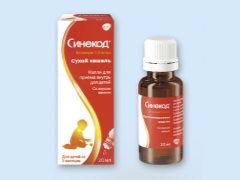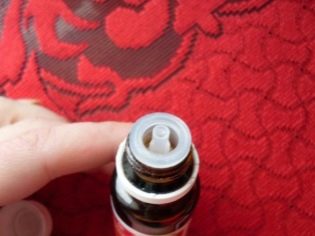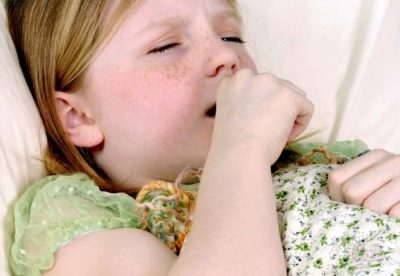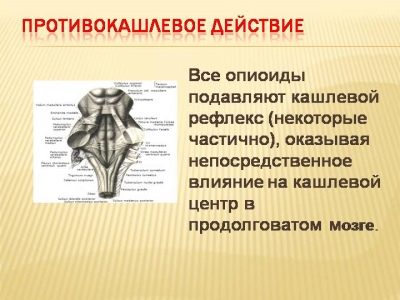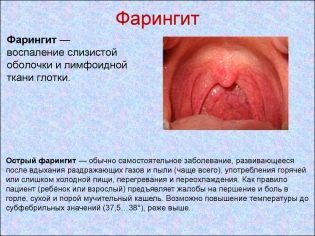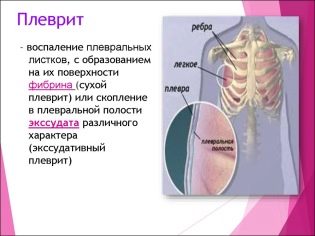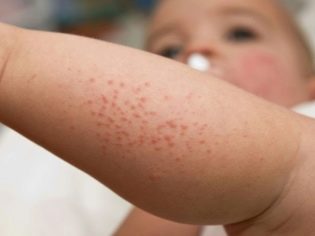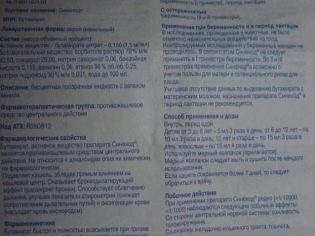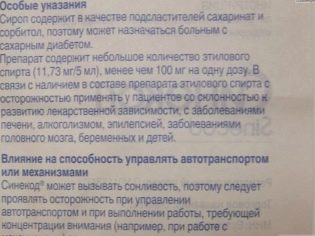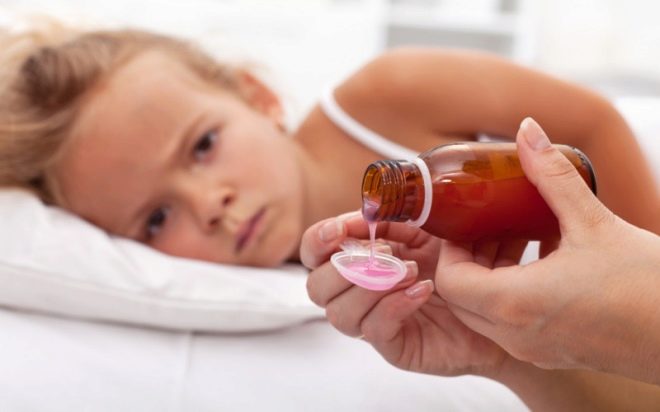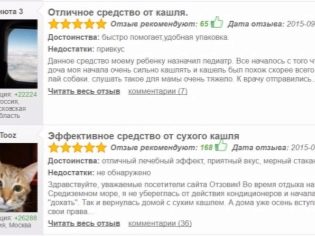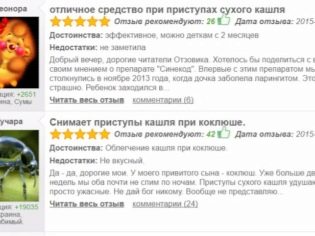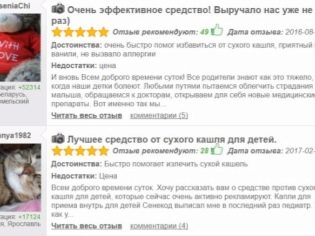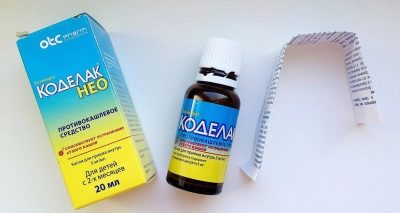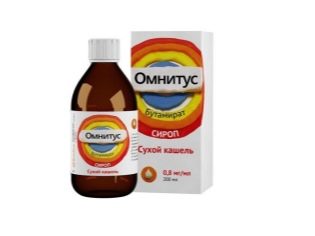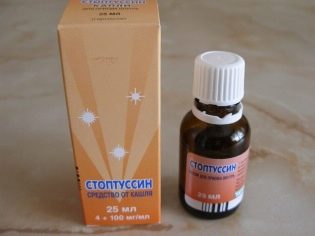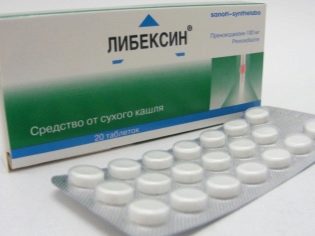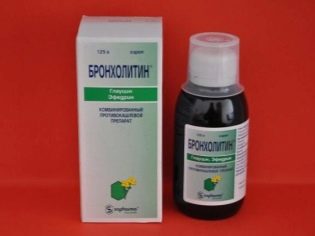Drops "Sinekod" for children: instructions for use
In the event of cough with sputum, which is called wet, different preparations with expectorant effect are used. But in some cases, the cough is dry and causes the sick person to suffer both day and night, without bringing relief.
To eliminate it, use medications that can affect the cough reflex. One of them is Sinekod. Such a medicine in the form of drops is in demand in adults with laryngitis, whooping cough and other diseases with a strong unproductive cough. But is it possible to apply it in childhood and how to do it correctly? What can harm overdosing and are there analogues of such a drug?
Release form
Drops Sinekod produced in glass bottles of small size, which have a dispenser-dropper. One bottle contains 20 ml of solution that smells like vanilla. It is transparent and often colorless, but may be yellowish. In addition to drops, Sinekod is also represented by syrup, and there are no such forms as tablets, injections or capsules.
Composition
The active ingredient by which drops can affect the cough reflex is called butamirata citrate. Each milliliter of solution contains this ingredient in a dose of 1.5 mg.
Among the excipients in the drug is glycerol, 96% ethyl alcohol, benzoic acid, water, 70% sorbitol and sodium hydroxide. They help the drug to remain in liquid form and not to deteriorate during storage. For sweet taste, sodium saccharinate is added to the preparation, and the aroma of drops is due to the presence of vanillin in its composition.
Mechanism of action
Sinekod has a central action, because butamirate can affect the cough center in the brain. With many diseases of the respiratory tract, the cause of cough is the formation of sputum, which must be removed. When it appears, receptors begin to send signals to the brain to activate the cough reflex and eliminate the irritant.
But if the cough is dry, then there is practically no sputum, and the cause of the signals from the receptors located in the mucosa is inflammation and irritation of the respiratory tract. And when a dry cough begins in response to an increase in the activity of the cough center, it does not bring relief, because sputum is absent, signals about its removal from the respiratory tract are not received and the reflex remains active.
As a result, the brain continues to receive signals of irritation of the mucous membrane and the need to remove sputum, which is not, therefore, the cough does not end there. And in this case there is a need for Sinekode, as in medicine that will inhibit the cough reflex, thanks to which the patient's condition will improve.
Drops not only help to get rid of coughing episodes, but also reduce the resistance of the respiratory tract, as well as contribute to a greater flow of oxygen into the bloodstream.
In addition, they have noted and some bronchodilating effect, that is, the use of Sinekod helps to expand the lumen of the bronchi. All these effects at the same time facilitate breathing and eliminate oxygen starvation of tissues, which speeds up recovery.
Indications
Since Sinekod in drops affects the cough reflex, it is prescribed in situations where the child suffers from a dry cough, worsening his condition. Especially often this symptom occurs at night, disrupting the sleep of the baby. The drug is in demand for such diseases:
- whooping cough;
- tracheitis;
- laryngotracheitis;
- bronchopneumonia;
- bronchitis;
- tracheobronchitis;
- laryngitis;
- pharyngitis;
- emphysema;
- pleurisy;
- bronchial asthma
Drops can also be used before various manipulations on the airways (for example, before bronchoscopy) or before surgical treatment. If a child has an acute respiratory viral infection, Sinekod is usually not prescribed, because with such problems a dry cough quickly goes into a wet one. However, if one of the symptoms is a painful dry cough, you can use drops, but as prescribed by a doctor and only until the time when the sputum begins to form and cough up in the sick baby.
At what age is children prescribed?
Drops Sinekod can be used from an early age, because the instructions for this form of medicine in contraindications indicate the age of up to 2 months. If the baby is already two months old, it is acceptable to give him a solution, but only after an examination by a doctor. Although the medication is considered safe, it is not a narcotic drug and rarely causes side effects, its use without the prescription of a pediatrician in children of the first years of life is unacceptable.
Syrup contains much more active substance in 1 ml, so it is not used until 3 years of age.
Children under three years old are allowed to give Sinekod exclusively in drops.
Contraindications
The drug is not used in the treatment of children who have an intolerance to any ingredient drops. In addition, the tool does not give the respiratory tract diseases occurring with a wet cough.
Side effects
Occasionally in the treatment with Sinekod arises:
- allergic rash;
- feeling nauseous;
- stool liquefaction;
- dizziness;
- sleepy state.
When any of these ailments occur, the drops are stopped and are referred to the attending physician.
Instructions for use
Drug prescribed to drink before meals four times a day. Before each use, shake the bottle so that the components of the solution mix well. The synecode is recommended to drip into a clean spoon or other small volume container.
To measure the required number of drops, the bottle is turned over the spoon vertically and the drops falling into the container are counted. Next, the drug give the child to drink without diluting with water. As soon as the baby swallows the medicine, you can offer to drink it in water in a small amount.
Single dose of Sinekod depends on the age of the small patient:
- If the baby is not yet a year old, then at one time he needs to give 10 drops.
- If the baby is between a year and three years old, then for such a patient a single dose of the drug is 15 drops.
- For children 3 years and older, 25 drops are measured at a time.
Giving Sinekod child, you need to make sure that the sick kid drank drops in the right dose. If the patient spits out the medicine, you cannot re-give it immediately after that, because this will increase the risk of overdose. In such a situation, you need to wait until the planned next dose and give the crumbs a full dose.
The duration of therapy with Sinekod for each child is determined by the attending physician, but the medication is usually used in short courses, not exceeding seven days.
If, after a week of taking the cough, it still worries the baby, you need to re-examine the doctor and other treatment.
Overdose
Although the drug is considered relatively safe in childhood, even a slight overdose can provoke drowsiness, dizziness, severe nausea or diarrhea. In some children, an excess of drops causes vomiting or lowers blood pressure. With such symptoms, they resort to gastric lavage and give the patient medication from the group of sorbents.
Interaction with other medicines
Since the main action of Sinekod is suppression of cough, it is forbidden to prescribe such drops simultaneously with mucolytic drugs and expectorant drugs. In the case of the joint use of such funds, the sputum will become more fluid and at the same time will accumulate in the airways. This can provoke bronchospasm and congestion of mucus in the respiratory tract, which often causes secondary infection.
With any other medicines Sinekod can be prescribed. This drug is often prescribed with antibacterial agents (Macropene, Sumamed, Ospamox and others), antiviral and anti-inflammatory drugs.
Terms of sale
Drops Sinekod sold in pharmacies without a prescription, but the examination of the doctor before buying this drug for a child is required, especially for patients under three years. For one bottle of medicine you need to pay an average of 350 rubles.
Storage features
It is necessary to keep a bottle of droplets at home out of the reach of children, because such a product has a sweet taste and pleasant aroma, which with easy access threatens with an overdose. Storage temperature synekod should not exceed 30 degrees Celsius.
Sealed drops have a rather long shelf life of 5 years. An opened bottle does not require special conditions (it should not be kept in the refrigerator), and the shelf life after the first use does not change.
Reviews
Parents about Sinekod in drops speak mostly positively, calling this medicine a highly effective remedy for dry and barking cough. According to many reviews of moms, this medicine quickly helped with tracheitis, laryngitis, whooping cough and other respiratory diseases, easing the condition of the little patient.
The main advantages of drops parents include the possibility of treating infants with this drug, sweet taste and ease of use. Among the shortcomings of such Sinekod often mention the high price, because the syrup is cheaper and there are less expensive analogues based on butamirate.
Also, some patients complain about the unpleasant taste of the medication. In addition, although rare, drops can cause negative side effects, such as nausea or a rash on the body.
Reviews of doctors about drops Sinekod also mostly good. Even the popular pediatrician Komarovsky classifies it as an effective medicine, but does not recommend taking it without prescribing a pediatrician or other specialist, because in some young patients it may cause a worsening of the condition.
Analogs
It is possible to replace Sinekod with other antitussive preparations - both on the basis of the same active component, and with a different composition. If it is impossible to apply the drops, the doctor may advise:
- Drops Codelac Neo. The action of this tool also provides butamirata citrate, presented in the same dosage. Like drops Sinekod, this medicine smells like vanilla and tastes sweet, it is allowed from 2 months and helps with dry cough, but one bottle of it is cheaper. Codelac Neo they are also produced in syrup - like synekod syrup, it is prescribed to patients over 3 years old.
- Omnitus syrup. The effectiveness of this drug when coughing is also associated with the presence in its composition of butamiraty. The medicine can be given to children older than 3 years, that is, it is rather an analogue of Sinekod in syrup. In addition, Omnitus is also produced in coated tablets. This remedy with a dosage of 20 mg can be given to schoolchildren and adolescents, since it is prescribed from the age of 6.
- Drops Stoptussin. The difference between such an antitussive drug from Sinekod is the presence of two active substances in the composition at once. One of them is butamirate, and the second is guaifenesin. The drug is in demand for eliminating dry irritating cough and can be given to children from 6 months of age. It is represented by a solid form, but such Stoptussin is contraindicated up to 12 years.
- Pills Libexin. Such an antitussive agent based on prenoxdiazine does not affect the brain, but affects receptors in the bronchi. Such tablets are often used for tracheitis, bronchitis and other diseases with unproductive cough. They can be given to children of any age, but with caution and only if the drug is prescribed by a doctor.
- Syrup Bronholitin. The antitussive effect of this agent causes the combination of glaucine with ephedrine. These ingredients further expand the bronchi and eliminate swelling, which helps ease breathing. Children, this medication can be given from 3 years. Its counterparts are the drugs Bronhoton and Bronhotsin, which are also represented by syrups.
- Pakseladin syrup. Its action on the brain is provided by okseladin. The drug not only reduces the severity of the cough reflex, but also stimulates breathing.
In childhood it can be used with a weight of more than 15 kg (the medication is prescribed from 2.5 years).
See the following video for instructions on receiving drops.
